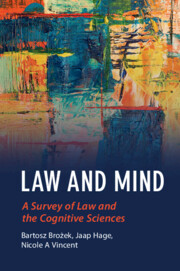Book contents
- Law and Mind
- Law and the Cognitive Sciences
- Law and Mind
- Copyright page
- Contents
- Figures
- Contributors
- Acknowledgements
- 1 Introduction
- I Metatheory and Methodology
- 2 Are the Cognitive Sciences Relevant for Law?
- 3 Social and Normative Facts
- 4 Law, Folk Psychology and Cognitive Science
- 5 Law and the Cognitive Science of Ordinary Concepts
- II Ontology and Epistemology
- III Legal Doctrine and Cognitive Sciences
- IV Evidence
- V Dissenting Opinions
- References
5 - Law and the Cognitive Science of Ordinary Concepts
from I - Metatheory and Methodology
Published online by Cambridge University Press: 21 April 2021
- Law and Mind
- Law and the Cognitive Sciences
- Law and Mind
- Copyright page
- Contents
- Figures
- Contributors
- Acknowledgements
- 1 Introduction
- I Metatheory and Methodology
- 2 Are the Cognitive Sciences Relevant for Law?
- 3 Social and Normative Facts
- 4 Law, Folk Psychology and Cognitive Science
- 5 Law and the Cognitive Science of Ordinary Concepts
- II Ontology and Epistemology
- III Legal Doctrine and Cognitive Sciences
- IV Evidence
- V Dissenting Opinions
- References
Summary
This chapter introduces the ‘folk law thesis’, the claim that ordinary concepts are at the heart of central legal concepts. It presents recent empirical work suggesting that a number of subtle and surprising features of ordinary concepts are also shared by the corresponding legal concept – including features of INTENT, KNOWLEDGE, CONSENT, REASONABLENESS, and CAUSATION. This approach to law opens up a range of new and promising empirical research questions: For each legal concept, what are the features of the corresponding ordinary concept – and what, if any, are the distinctive features of that legal concept? It also opens up an equally vast range of new normative questions: For each feature of the relevant ordinary concept, we can – and should – ask a corresponding normative question: should the legal concept have this or that feature? In this way, the cognitive science of ordinary concepts is not only a useful part of legal psychology, but also a critical part of legal theory and jurisprudence.
- Type
- Chapter
- Information
- Law and MindA Survey of Law and the Cognitive Sciences, pp. 86 - 96Publisher: Cambridge University PressPrint publication year: 2021
References
- 6
- Cited by



